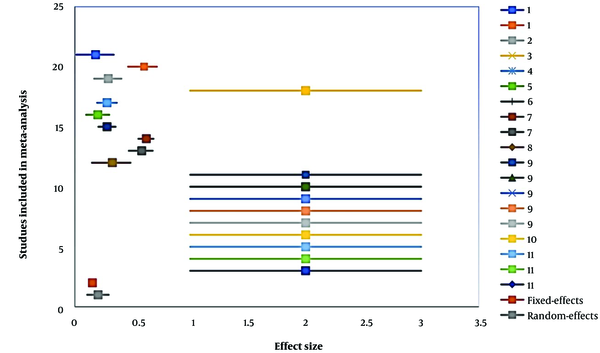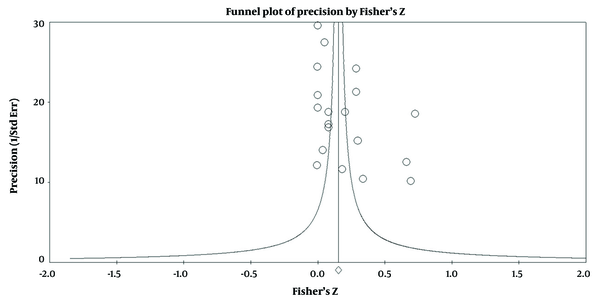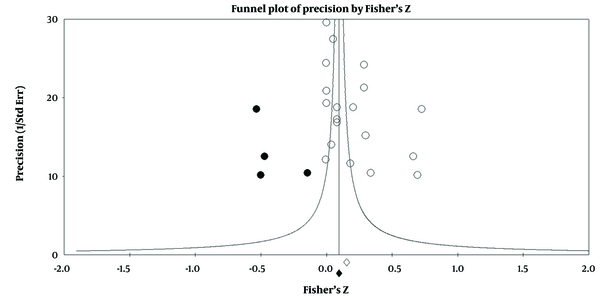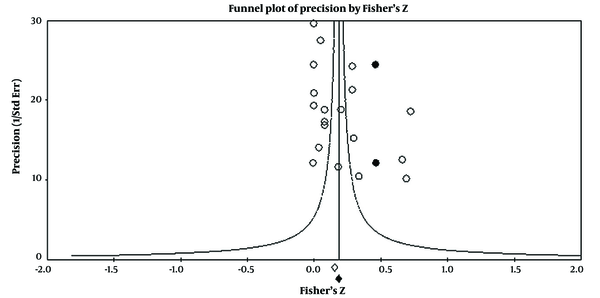1. Background
Addiction as a pathology has undergone numerous changes over time. Psychologists define addiction as any behavior that results in temporary pleasure or relief such that the person tolerates its consequences and gives in to the challenge (1). Overall, these behaviors are associated with craving, relief, short-term pleasure, inability to quit, and long-term consequences. Behavioral analysis is essential to the investigation of addiction as an interdisciplinary subject (2). Addiction is now regarded as an illness and should be examined as a psychological, cultural, and social behavior by emphasizing personality traits, such as impulsivity and lack of control. Human beings are entangled in modernism, consumerism, and pleasure-seeking in pathologic models. Self-control is systematically weakened in this setting, resulting in a broad spectrum of addiction, including gambling and sex addiction, which should be included in addiction modeling (3).
The narcotic abuse disorder spectrum is based on dependence, and the initial impulsive behavior for experimentation and stressors as a dimension of lack of control form the etiology of different addictive behaviors, especially sex addiction (4). The role of impulsive behavior in sex addiction has caused subtle and fundamental contradictions in psychological references. Although sex addiction has been removed from the fifth edition of the Diagnostic and Statistical Manual of Mental Disorders (DSM-5), it is still a subgroup of addictive behaviors. Sex addiction is introduced as compulsive sexual behavior and a subtype of impulse control disorders in the latest revision of the International Classification of Diseases (ICD-11) (2018) (5-7). Impulsivity is a disparate component of the character structure, which manifests as the tendency to act in a hasty and ill-considered way prompted by intrinsic motivation. This presumed urgency, unpredictable behaviors, and lack of abstinence lead to a negative emergency state, which manifests first as impulsive behaviors and then as addictive behaviors with underlying patterns (6). Impulsive behaviors reduce delayed gratification, disrupt behavior control, and bring about a sense of excitement and risk-taking by focusing on the moment. This combination leads to uncontrolled behaviors and failure to adhere to purposeful schedules accompanied by impatience and pleasure-seeking (7).
Impulsivity and compulsive behavior co-occur as impulsive-compulsive behaviors in compulsive buying, overeating, and sexual relations, despite their distinction. Impulsivity is also examined physiologically due to its nature. Scientific evidence implicates dopamine and the brain and limbic system dysfunction, as the etiology of impulsivity (8). Impulsivity also leads to personal and social risks and pathologies, including addiction, which has always been a critical research topic due to human behavior complexity. Zhang (9) demonstrated the relationship between neuroticism, impulsivity, and Internet addiction among Chinese university students. Wegmann et al. (10) studied various age groups (adolescents to middle-aged individuals) and found that impulsivity affected executive functions and social network addiction symptoms. Marzilli et al. (11) demonstrated that emotional conflicts within the family directly affect Internet addiction, while impulsivity is a mediator indirectly and significantly affects Internet addiction.
Furthermore, Cudo et al. (4) showed the effect of abstinence, self-control, and impulsivity on addictive tendencies and reported them as significant factors in addiction prevention programs. de Sousa Fernandes et al. (12) conducted a systematic review and meta-analysis of 12 research articles covering food addiction from childhood to adulthood and found that impulsivity plays a significant role. Review studies have revealed that impulsivity is affected by brain damage, alcohol abuse, sleep disorders, traumatic experiences, and mental conditions (7). Stress and unpleasant emotional experiences are specifically involved in the prognosis of addiction tendencies and failed attempts at problem-solving (13).
In addition to personal problems, human beings have always experienced a variety of stressors such as floods, wars, earthquakes, and terrorist attacks, which disrupt the dynamism and infrastructure of society. During the COVID-19 pandemic of 2020, the global community faced a huge disaster, which affected all aspects of life. The crisis was so severe in such a short period that its consequences are expected to persist for years. Behavioral conflicts have been caused by this extreme form of mental, as well as external, pressure, which causes some people to remain strong but causes other people to act in an ineffective manner (14). Addictive behaviors are highly inefficient as a source of increasing concern for families and society, accompanied by seclusive behavior due to incorrect use of all personal potentials and capabilities in the face of problems (15). The modern world has created an atmosphere, which increases the incidence of addictive behaviors with increased public stress and anxiety, as well as the imposed seclusion. Addiction is a priority for psychiatric services, whose impact on mental health requires changing health service priorities and effective and sustainable service provision to those prone to addiction (16, 17).
2. Objectives
The present study aimed to explore the literature to identify the effect of impulsivity on addictive tendencies and behaviors based on secondary data via a process to save costs, time, and energy when examining large samples and populations on a global scale. The study purpose was to synthesize findings during the imposed changes, stress, and trauma caused by the COVID-19 pandemic. This study addressed the effect size of impulsivity on addictive tendencies and behaviors by synthesizing research findings and computing the effect size.
3. Methods
The current meta-analysis reviewed quantitative research, and statistically synthesized the findings of independent studies for a general conclusion about the study designs. Clear responses can be found in the literature to serve specific goals with the potential of meta-analysis. Meta-analyses provide a meta-evaluation of independent analyses through secondary convergence analysis of research findings based on the effect size index as a fundamental element of meta-analysis (18). The analysis unit in this multi-level method is the quantitative findings of other studies. Therefore, the statistical population of the current study comprised all studies worldwide with the keywords of impulsivity, addiction, addictive behavior, and tendency to addiction, indexed in scientific databases. The ResearchGate scientific, social network was also searched to avoid sampling bias (the file drawer problem) and include both significant and non-significant results. The studies were published from 2020 to March 2021 during the COVID-19 pandemic. Meta-analyses do not rely on the results of a single study or traditional non-quantitative reviews and provide an overall picture of research activity contrary to narrative syntheses. As a result, researchers should not include/exclude studies based on their intuition and judgment to provide a systematic and step-by-step model for analyzing and synthesizing of results. The studies were searched based on a study selection protocol delineating the identification, screening, eligibility check, and inclusion steps. Initially, 143 articles were identified as relevant documents, of which 19 were included in the screening phase, and eight articles were excluded due to their imprecise analysis, non-probability sampling, an inappropriate instrument for accurately identifying impulsivity, or being conducted in 2017 and 2018. Finally, 11 articles were included in this meta-analysis as a suitable sample size for examining the hypothesis.
A checklist was developed for collecting data based on the article title, author specifications, publication year, setting, research type, hypothesis, data collection instrument, statistical population, sample size, significance level, and probability value to avoid bias in the study selection protocol (Table 1). Each study was converted into effect size categories via the Comprehensive Meta-Analysis software (CMA) version 2.0 to have a unified criterion for comparison because of the different geographical and cultural conditions, qualities, test results, and statistical analyses. Then, the results of these studies were synthesized with the fixed and random-effects models. Subsequently, the tests were run to examine the homogeneity of the studies, and finally, the quality of research was investigated in terms of different types of bias.
| Row | Article Selection Criteria |
|---|---|
| 1 | Year of publication (studies published from 2020 to March 2021 and conducted during the COVID-19 pandemic) |
| 2 | Method (descriptive) |
| 3 | Type of hypothesis (causal) |
| 4 | Statistical tests (regression analysis, path analysis, SEM) |
| 5 | Establishing the reliability or generalizability of results (Cronbach's alpha) |
| 6 | Sampling method (probability sampling, depending on the nature of the study) |
| 7 | Appropriate sample size |
| 8 | Data collection instrument (standard questionnaire) |
Study Selection Protocol
4. Results
Studies on impulsivity-induced addiction have hypothesized the effect of impulsivity on addiction (Table 2). These studies were published in the determined period, and their geographical distribution suggests the absence of studies in Iranian databases aligned with the protocol. The majority of these studies dealt with Internet and social network addiction (63%), gambling (11%), sex addiction (5%), food addiction (5%), and shopping addiction (5%). A total of 6836 men and women aged > 12 years, mostly belonging to non-clinical groups of students, were examined in descriptive studies. Some studies have separately tested their hypotheses in sub-groups of sex and addiction tendencies.
| Row | The Subject of Research | Research Instruments | Sample Size | References |
|---|---|---|---|---|
| 1 | Internet addiction among young adult university students: The complex interplay between family functioning, impulsivity, depression, and anxiety. | Internet Addiction Test (IAT); The Barratt Impulsiveness Scale (BIS) | 244 (106 males, 138 females) | Marzilli et al. (11) |
| 2 | Dysfunction of self-control in Facebook addiction: impulsivity is the key | The Facebook Intrusion Questionnaire; The Brief Self-Control Scale; The Action Control Scale (ACS-90) | 234 (20 males, 214 females) | Cudo et al. (4) |
| 3 | The association of impulsivity and family history of alcohol use disorder on alcohol use and consequences. | The Barratt Impulsiveness Scale (BIS); Short Inventory of Problems (SIP) | 757 (378 males, 379 females) | Haeny et al. (6) |
| 4 | Direct and indirect effects of neuroticism on internet addiction in college students: a structure equation modeling analysis | Young's Diagnostic Questionnaire (YDQ); The Barratt Impulsiveness Scale (BIS) | 455 (235 males, 221 females) | Zhang (9) |
| 5 | A study on the influence of smartphone addiction risk factors on self-elasticity and smart phone addiction in teenagers | Smartphone addiction scale (SAS); The Barratt Impulsiveness Scale (BIS) | 356 (197 males, 159 females) | Park and Ryou (19) |
| 6 | Impact of materialistic values on impulsive and compulsive consumption via status consumption: A research on young consumers | Rook and Fisher's Impulsive Buying Scale; Addictive Buying | 589 (400 males, 189 females) | Tokgoz (20) |
| 7 | Insecure attachment and technology addiction among young adults: the mediating role of impulsivity, alexithymia, and general psychological distress. | Internet Addiction Test (IAT); The Barratt Impulsiveness Scale (BIS) | 534 (160 males, 347 females) | Remondi et al. (21) |
| 8 | Interactions of impulsivity, general executive functions, and specific inhibitory control explain symptoms of social-networks-use disorder: An experimental study | short Internet Addiction Test (sIAT); The Barratt Impulsiveness Scale (BIS) | 112 (49 males, 63 females) | Wegmann et al. (10) |
| 9 | The influence of trait compulsivity and impulsivity on addictive and compulsive behaviors during | Short UPPS-P Impulsivity Scale; The Cambridge-Chicago Compulsivity Trait Scale | 878 (412 males, 466 females) | Albertella et al. (22) |
| 10 | Problem gambling during Covid-19 | The South Oaks Gambling Screen (SOGS); The Barratt Impulsiveness Scale (BIS) | 200 (75 males, 125 females) | Frisone et al. (23) |
| 11 | Predicting tendencies towards the disordered use of Facebook’s social media platforms: On the role of personality, impulsivity, and social anxiety | The Smartphone Addiction Scale - Short Version (SAS-SV); The Barratt Impulsiveness Scale (BIS) | 444 (314 males, 130 females) | Sindermann et al. (24) |
Studies Included in Meta-analysis and Descriptive Results
The reports extracted from the sample were converted into effect size r in comparison to Cohen’s d. According to Mikolajewicz and Komarova (25), effect size r and Cohen’s d indices have more significant conversions and enable trend analysis for more than two groups. Table 3 presents the ranking, and interpretations of these indices in the studies.
| Research Number | Group | Effect Size | Lower Limit | Upper Limit | z | P | Interpretation | Prioritization |
|---|---|---|---|---|---|---|---|---|
| 1 | Female group | 0.18 | 0.01 | 0.34 | 2.11 | 0.034 | Medium | Eighth |
| Male group | 0.60 | 0.46 | 0.71 | 7.03 | 0.001 | Large | Second | |
| 2 | Total | 0.29 | 0.17 | 0.40 | 4.54 | 0.001 | Medium | Fifth |
| 3 | Total | 0.05 | 0.02 | 0.12 | 1.37 | 0.169 | - | - |
| 4 | Total | 0.28 | 0.19 | 0.36 | 6.11 | 0.001 | Medium | Sixth |
| 5 | Total | 0.20 | 0.09 | 0.29 | 3.80 | 0.001 | Medium | Seventh |
| 6 | Total | 0.28 | 0.20 | 0.35 | 6.96 | 0.001 | Medium | Sixth |
| 7 | Female group | 0.62 | 0.55 | 0.68 | 13.44 | 0.001 | Large | First |
| Male group | 0.58 | 0.47 | 0.67 | 8.30 | 0.001 | Large | Third | |
| 8 | Total | 0.32 | 0.15 | 0.48 | 3.52 | 0.001 | Large | Fourth |
| 9 | Subgroup 1 | -0.001 | -0.07 | 0.06 | -0.03 | 0.976 | - | - |
| Subgroup 2 | -0.006 | -0.16 | 0.15 | -0.07 | 0.942 | - | - | |
| Subgroup 3 | 0.001 | -0.09 | 0.09 | 0.02 | 0.983 | - | - | |
| Subgroup 4 | -0.001 | -0.10 | 0.10 | -0.02 | 0.985 | - | - | |
| Subgroup 5 | -0.002 | -0.08 | 0.08 | -0.05 | 0.961 | - | - | |
| 10 | Total | 0.04 | 0.10 | 0.17 | 0.52 | 0.603 | - | - |
| 11 | Subgroup 1 | 0.08 | 0.02 | 0.18 | 1.50 | 0.133 | - | - |
| Subgroup 2 | 0.08 | -0.03 | 0.19 | 1.38 | 0.166 | - | - | |
| Subgroup 3 | 0.08 | -0.04 | 0.19 | 1.34 | 0.177 | - | - |
The Effect Size, Ranking and Interpretation of Each Study
Effect size suggests the deviation of the null hypothesis from the alternative hypothesis, interpreted based on three levels of 0.1, 0.3, and 0.5 for r (Cohen, 1998). The range of 0 - 0.1, 0.1 - 0.3, and 0.3 - 0.5 denotes a small, moderate, and large effect size, respectively. The smaller the effect size refers to the higher value of the sample size, precision of results, and the generalizability. Large effect sizes are desirable in studies using primary data, whereas moderate effect sizes are optimal in meta-analyses. The displayed ranking shows studies with strong, moderate, and poor precision and generalizability. Based on Table 3, the effect size of studies number 3, 9, 10, and 11 is not significant. The study by Remondi et al. (21) had a significant effect size and ranked first.
Unlike, the study by Marzilli et al. (11) on women had the slightest effect size (the most robust study) and ranked eighth (significant at 95% confidence level). The other seven studies were significant (P < 0.001) and fell near the centerline of the effect size range. A combination analysis was performed to confirm or reject the research hypothesis and present the overall outcome of the studies (Table 4).
| Models | Effect Size | Lower Limit | Upper Limit | z | P |
|---|---|---|---|---|---|
| Fixed-effects | 0.15 | 0.13 | 0.18 | 12.66 | 0.001 |
| Random-effects | 0.20 | 0.11 | 0.29 | 4.14 | 0.001 |
Combined Analysis Models of Results
The result synthesis of 11 studies in fixed-effects and random-effects models was significant (P < 0.001). The fixed-effects model demonstrated the homogeneity of the studies, and the differences were attributed to sampling differences. The random-effects model also showed the independence and heterogeneity of the studies. The significance (z-value) and probability level (P-value) rejected the null hypothesis and confirmed the alternative hypothesis (P < 0.001). Accordingly, impulsivity significantly and positively affected addictive tendencies and behaviors at the 99% confidence level.
Based on Figure 1, less detailed studies had a more significant deviation, while more detailed studies were closer to the effect size centerline in line with the population. Seven studies had a significant effect size.
The homogeneity of the studies was examined by three tests to assess the quality of results (Table 5). The q-value test, which is the most crucial diagnostic test, equaled 285.010 at the 99% confidence level (P < 0.001), rejecting the null hypothesis, confirming the alternative hypothesis, and demonstrating the heterogeneity of the studies. Approximately, I2 tests with a range of 0 - 100 equaled 93.684. Based on Ortega’s classification, 25, 50, and 75 values denote low, moderate, and high heterogeneity. Therefore, the results of the studies were independent. The value of the Tau2 test (0.042) was deficient, indicating that the random-effects model presents a more realistic solution. There was a bias in publishing significant and non-significant results, i.e., the file drawer problem. Then, the publication bias was examined via a funnel plot, Duval and Tweedie’s trim and fill test, and the fail-safe N test.
| Statistical Index | q-Value | I2 | Tau2 | P |
|---|---|---|---|---|
| Results | 285.01 | 93.68 | 0.04 | 0.001 |
The Homogeneity of the Studies Included in the Meta-analysis
Figure 2 graphically distinguishes strong and weak studies based on effect size and error indicators. More robust studies are at the top, and weak ones are at the bottom of the funnel. The symmetry shows the absence of publication bias in the fixed-effects model. As the fixed and random-effects models were significant, the trim and fill method was performed.
Duval and Tweedie’s test showed four missing studies in the fixed-effects model (Figure 3) with no publication bias in the random-effects model (Figure 4). Table 6 presents the results of the classic fail-safe N test. The value of 977 indicates the acceptable robustness of the theory arising from the current meta-analysis compared to the data of past, present, and future unpublished studies.
| Index | Values |
|---|---|
| z for observed studies | 14.18 |
| Observed z-score for studies | 0.001 |
| Alpha | 0.05 |
| Residual | 2.00 |
| z for alpha | 1.96 |
| Number of missing studies that would bring P-value to alpha | 977 |
Fail-safe N Calculation
5. Discussion
This meta-analysis study aimed to investigate the effect of impulsivity on addition and addictive tendencies. Any change in the environment can cause anxiety and stress. In today's world, a hazardous emergency situation has caused severe health threats, forced lifestyle changes, and caused socioeconomic difficulties, resulting in mental illnesses, including addictive behaviors and tendencies. Addictive tendencies alleviate stress in the face of physical and mental burnout due to the perceived conflict between situational requirements and personal resources. In the current era, cognitive and behavioral interactions with the environment have been replaced by seclusion, which is accompanied by psychological incompetence, leading to destructive and harmful behaviors. Unofficial statistics suggest a rising trend of smoking and alcohol, OTC medication, and synthetic narcotic consumption (16). With the onset of adolescence, emotional coping mechanisms are transformed into unhealthy addictive behaviors and tendencies to deal with stressful situations (26). Accordingly, future mental crisis management problems should pay attention to impulsivity.
The present meta-analysis concluded that the behavioral construct of impulsivity significantly and positively affected addictive behaviors and tendencies during the COVID-19 pandemic with fixed and random effects of 0.153 and 0.202, respectively. The combined effect size (fixed-effects model) revealed that the studies significantly share an actual effect size, and the difference in effect sizes can be attributed to sampling error. The significance of the random-effects model suggested the independence of the studies. These findings are consistent with a systematic review by Chowdhury et al. (27) showing the effect of impulsivity on the pathology of gambling. Li et al. (28) also conducted a meta-analysis of studies published until 2019 on impulsivity, anxiety, depression, sleep quality, and smartphone addiction and showed a significant positive correlation between impulsivity and smartphone addiction among students. Similarly, Fisher et al. (29) and Fowler et al. (30) examined impulsivity in different periods and demonstrated its effect on addiction and addictive tendencies.
Dangerous impulsive behaviors are characterized by reward-seeking, lack of inhibition and planning, risk-taking, and pleasure-seeking behaviors coupled without cognitive control in coping with difficult situations and forming addictive tendencies. impulsivity creates a tendency to addiction and endangers one's well-being with temporary and seemingly adaptive stress regulation with uninhibited social anxiety and the inability to manage negative emotions (31). The acquired preparedness model emphasizes impulsivity as a factor in predisposing people with cognitive biases to seek positive experiences. Impulsivity has a complex and multi-faceted structure and involves multiple neurological, cognitive, and motor processes as a mental construct. Impulsivity causes addictive tendencies and behaviors by leading to uninhibited behaviors (27). All narcotic spectrum disorders and even addictions removed from psychological references share the feature of uninhibited behavior. Therefore, addiction should be explained not based on a disease model rather than behavior. Nevertheless, clinicians still examine many addictive behaviors, such as sex addiction as a mental disorder, while research suggests a behavioral origin for addition.
5.1. Conclusions
A lot of resources need to be invested to address addiction when it is viewed as an obstacle for realizing sustainable health development, satisfying current and future human needs, and causing social, economic, and health related problems. Different addictions afflict different age groups, diminish their social capital, increase conflicts with parents, and lead to generational gaps with the individualism and social seclusion of the modern world. Measures are required to control the mediating effect of impulsivity (with a biological model), promote resilience (as an index of behavior control), and train protective strategies for individuals prone to addiction to improve mental health quality and develop social, communication, and life skills. Considering the heterogeneity observed between studies and the recent emergence of new addictions (e.g., internet and sex addiction), we recommend future studies consider impulsivity as a moderator variable and use its components in treatment.



